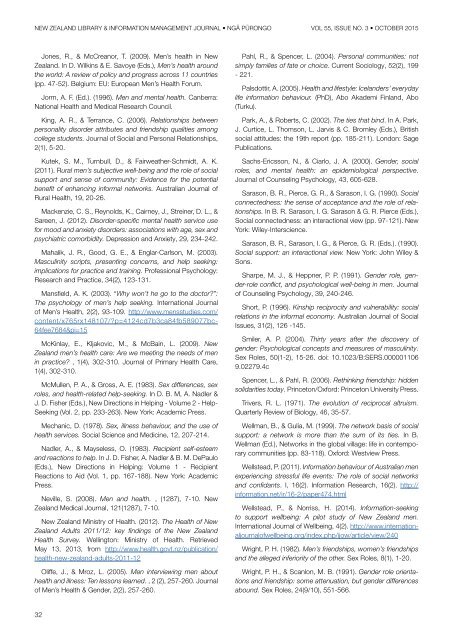THE NEW ZEALAND LIBRARY & INFORMATION MANAGEMENT JOURNAL NGĀ PŪRONGO
NZLIMJ%20Vol%2055%20Issue%203
NZLIMJ%20Vol%2055%20Issue%203
Create successful ePaper yourself
Turn your PDF publications into a flip-book with our unique Google optimized e-Paper software.
<strong>NEW</strong> <strong>ZEALAND</strong> <strong>LIBRARY</strong> & <strong>INFORMATION</strong> <strong>MANAGEMENT</strong> <strong>JOURNAL</strong> • <strong>NGĀ</strong> <strong>PŪRONGO</strong> VOL 55, ISSUE NO. 3 • OCTOBER 2015<br />
Jones, R., & McCreanor, T. (2009). Men’s health in New<br />
Zealand. In D. Wilkins & E. Savoye (Eds.), Men’s health around<br />
the world: A review of policy and progress across 11 countries<br />
(pp. 47-52). Belgium: EU: European Men’s Health Forum.<br />
Jorm, A. F. (Ed.). (1996). Men and mental health. Canberra:<br />
National Health and Medical Research Council.<br />
King, A. R., & Terrance, C. (2006). Relationships between<br />
personality disorder attributes and friendship qualities among<br />
college students. Journal of Social and Personal Relationships,<br />
2(1), 5-20.<br />
Kutek, S. M., Turnbull, D., & Fairweather-Schmidt, A. K.<br />
(2011). Rural men’s subjective well-being and the role of social<br />
support and sense of community: Evidence for the potential<br />
benefit of enhancing informal networks. Australian Journal of<br />
Rural Health, 19, 20-26.<br />
Mackenzie, C. S., Reynolds, K., Cairney, J., Streiner, D. L., &<br />
Sareen, J. (2012). Disorder-specific mental health service use<br />
for mood and anxiety disorders: associations with age, sex and<br />
psychiatric comorbidity. Depression and Anxiety, 29, 234-242.<br />
Mahalik, J. R., Good, G. E., & Englar-Carlson, M. (2003).<br />
Masculinity scripts, presenting concerns, and help seeking:<br />
implications for practice and training. Professional Psychology:<br />
Research and Practice, 34(2), 123-131.<br />
Mansfield, A. K. (2003). “Why won’t he go to the doctor?”:<br />
The psychology of men’s help seeking. International Journal<br />
of Men’s Health, 2(2), 93-109. http://www.mensstudies.com/<br />
content/x765rx148107/?p=4124cd7b3ca84fb589077bc-<br />
64fee7684&pi=15<br />
McKinlay, E., Kljakovic, M., & McBain, L. (2009). New<br />
Zealand men’s health care: Are we meeting the needs of men<br />
in practice? , 1(4), 302-310. Journal of Primary Health Care,<br />
1(4), 302-310.<br />
McMullen, P. A., & Gross, A. E. (1983). Sex differences, sex<br />
roles, and health-related help-seeking. In D. B. M, A. Nadler &<br />
J. D. Fisher (Eds.), New Directions in Helping - Volume 2 - Help-<br />
Seeking (Vol. 2, pp. 233-263). New York: Academic Press.<br />
Mechanic, D. (1978). Sex, illness behaviour, and the use of<br />
health services. Social Science and Medicine, 12, 207-214.<br />
Nadler, A., & Mayseless, O. (1983). Recipient self-esteem<br />
and reactions to help. In J. D. Fisher, A. Nadler & B. M. DePaulo<br />
(Eds.), New Directions in Helping: Volume 1 - Recipient<br />
Reactions to Aid (Vol. 1, pp. 167-188). New York: Academic<br />
Press.<br />
Neville, S. (2008). Men and health. , (1287), 7-10. New<br />
Zealand Medical Journal, 121(1287), 7-10.<br />
New Zealand Ministry of Health. (2012). The Health of New<br />
Zealand Adults 2011/12: key findings of the New Zealand<br />
Health Survey. Wellington: Ministry of Health. Retrieved<br />
May 13, 2013, from http://www.health.govt.nz/publication/<br />
health-new-zealand-adults-2011-12<br />
Oliffe, J., & Mroz, L. (2005). Men interviewing men about<br />
health and illness: Ten lessons learned. , 2 (2), 257-260. Journal<br />
of Men’s Health & Gender, 2(2), 257-260.<br />
Pahl, R., & Spencer, L. (2004). Personal communities: not<br />
simply families of fate or choice. Current Sociology, 52(2), 199<br />
- 221.<br />
Palsdottir, A. (2005). Health and lifestyle: Icelanders’ everyday<br />
life information behaviour. (PhD), Abo Akademi Finland, Abo<br />
(Turku).<br />
Park, A., & Roberts, C. (2002). The ties that bind. In A. Park,<br />
J. Curtice, L. Thomson, L. Jarvis & C. Bromley (Eds.), British<br />
social attitudes: the 19th report (pp. 185-211). London: Sage<br />
Publications.<br />
Sachs-Ericsson, N., & Ciarlo, J. A. (2000). Gender, social<br />
roles, and mental health: an epidemiological perspective.<br />
Journal of Counseling Psychology, 43, 605-628.<br />
Sarason, B. R., Pierce, G. R., & Sarason, I. G. (1990). Social<br />
connectedness: the sense of acceptance and the role of relationships.<br />
In B. R. Sarason, I. G. Sarason & G. R. Pierce (Eds.),<br />
Social connectedness: an interactional view (pp. 97-121). New<br />
York: Wiley-Interscience.<br />
Sarason, B. R., Sarason, I. G., & Pierce, G. R. (Eds.). (1990).<br />
Social support: an interactional view. New York: John Wiley &<br />
Sons.<br />
Sharpe, M. J., & Heppner, P. P. (1991). Gender role, gender-role<br />
conflict, and psychological well-being in men. Journal<br />
of Counseling Psychology, 39, 240-246.<br />
Short, P. (1996). Kinship reciprocity and vulnerability: social<br />
relations in the informal economy. Australian Journal of Social<br />
Issues, 31(2), 126 -145.<br />
Smiler, A. P. (2004). Thirty years after the discovery of<br />
gender: Psychological concepts and measures of masculinity.<br />
Sex Roles, 50(1-2), 15-26. doi: 10.1023/B:SERS.000001106<br />
9.02279.4c<br />
Spencer, L., & Pahl, R. (2006). Rethinking friendship: hidden<br />
solidarities today. Princeton/Oxford: Princeton University Press.<br />
Trivers, R. L. (1971). The evolution of reciprocal altruism.<br />
Quarterly Review of Biology, 46, 35-57.<br />
Wellman, B., & Gulia, M. (1999). The network basis of social<br />
support: a network is more than the sum of its ties. In B.<br />
Wellman (Ed.), Networks in the global village: life in contemporary<br />
communities (pp. 83-118). Oxford: Westview Press.<br />
Wellstead, P. (2011). Information behaviour of Australian men<br />
experiencing stressful life events: The role of social networks<br />
and confidants. I, 16(2). Information Research, 16(2). http://<br />
information.net/ir/16-2/paper474.html<br />
Wellstead, P., & Norriss, H. (2014). Information-seeking<br />
to support wellbeing: A pilot study of New Zealand men.<br />
International Journal of Wellbeing, 4(2). http://www.internationaljournalofwellbeing.org/index.php/ijow/article/view/240<br />
Wright, P. H. (1982). Men’s friendships, women’s friendships<br />
and the alleged inferiority of the other. Sex Roles, 8(1), 1-20.<br />
Wright, P. H., & Scanlon, M. B. (1991). Gender role orientations<br />
and friendship: some attenuation, but gender differences<br />
abound. Sex Roles, 24(9/10), 551-566.<br />
32


